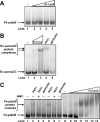Role of Pseudomonas aeruginosa dinB-encoded DNA polymerase IV in mutagenesis
- PMID: 17041045
- PMCID: PMC1698252
- DOI: 10.1128/JB.01481-06
Role of Pseudomonas aeruginosa dinB-encoded DNA polymerase IV in mutagenesis
Abstract
Pseudomonas aeruginosa is a human opportunistic pathogen that chronically infects the lungs of cystic fibrosis patients and is the leading cause of morbidity and mortality of people afflicted with this disease. A striking correlation between mutagenesis and the persistence of P. aeruginosa has been reported. In other well-studied organisms, error-prone replication by Y family DNA polymerases contributes significantly to mutagenesis. Based on an analysis of the PAO1 genome sequence, P. aeruginosa contains a single Y family DNA polymerase encoded by the dinB gene. As part of an effort to understand the mechanisms of mutagenesis in P. aeruginosa, we have cloned the dinB gene of P. aeruginosa and utilized a combination of genetic and biochemical approaches to characterize the activity and regulation of the P. aeruginosa DinB protein (DinB(Pa)). Our results indicate that DinB(Pa) is a distributive DNA polymerase that lacks intrinsic proofreading activity in vitro. Modest overexpression of DinB(Pa) from a plasmid conferred a mutator phenotype in both Escherichia coli and P. aeruginosa. An examination of this mutator phenotype indicated that DinB(Pa) has a propensity to promote C-->A transversions and -1 frameshift mutations within poly(dGMP) and poly(dAMP) runs. The characterization of lexA+ and DeltalexA::aacC1 P. aeruginosa strains, together with in vitro DNA binding assays utilizing cell extracts or purified P. aeruginosa LexA protein (LexA(Pa)), indicated that the transcription of the dinB gene is regulated as part of an SOS-like response. The deletion of the dinB(Pa) gene sensitized P. aeruginosa to nitrofurazone and 4-nitroquinoline-1-oxide, consistent with a role for DinB(Pa) in translesion DNA synthesis over N2-dG adducts. Finally, P. aeruginosa exhibited a UV-inducible mutator phenotype that was independent of dinB(Pa) function and instead required polA and polC, which encode DNA polymerase I and the second DNA polymerase III enzyme, respectively. Possible roles of the P. aeruginosa dinB, polA, and polC gene products in mutagenesis are discussed.
Figures






Similar articles
-
The dinB gene encodes a novel E. coli DNA polymerase, DNA pol IV, involved in mutagenesis.Mol Cell. 1999 Aug;4(2):281-6. doi: 10.1016/s1097-2765(00)80376-7. Mol Cell. 1999. PMID: 10488344
-
Specificity of replicative and SOS-inducible DNA polymerases in frameshift mutagenesis: mutability of Salmonella typhimurium strains overexpressing SOS-inducible DNA polymerases to 30 chemical mutagens.DNA Repair (Amst). 2006 Apr 8;5(4):465-78. doi: 10.1016/j.dnarep.2005.12.010. Epub 2006 Feb 7. DNA Repair (Amst). 2006. PMID: 16455311
-
Role of DNA polymerase IV in Escherichia coli SOS mutator activity.J Bacteriol. 2006 Nov;188(22):7977-80. doi: 10.1128/JB.01088-06. Epub 2006 Sep 15. J Bacteriol. 2006. PMID: 16980447 Free PMC article.
-
The "tale" of UmuD and its role in SOS mutagenesis.Bioessays. 2002 Feb;24(2):141-8. doi: 10.1002/bies.10040. Bioessays. 2002. PMID: 11835278 Review.
-
Properties and functions of Escherichia coli: Pol IV and Pol V.Adv Protein Chem. 2004;69:229-64. doi: 10.1016/S0065-3233(04)69008-5. Adv Protein Chem. 2004. PMID: 15588845 Review.
Cited by
-
The Pseudomonas aeruginosa AlgZR two-component system coordinates multiple phenotypes.Front Cell Infect Microbiol. 2014 Jun 20;4:82. doi: 10.3389/fcimb.2014.00082. eCollection 2014. Front Cell Infect Microbiol. 2014. PMID: 24999454 Free PMC article. Review.
-
Epistatic roles for Pseudomonas aeruginosa MutS and DinB (DNA Pol IV) in coping with reactive oxygen species-induced DNA damage.PLoS One. 2011 Apr 18;6(4):e18824. doi: 10.1371/journal.pone.0018824. PLoS One. 2011. PMID: 21533111 Free PMC article.
-
Genomics of Diversification of Pseudomonas aeruginosa in Cystic Fibrosis Lung-like Conditions.Genome Biol Evol. 2022 May 31;14(6):evac074. doi: 10.1093/gbe/evac074. Genome Biol Evol. 2022. PMID: 35660861 Free PMC article.
-
Multiple strategies for translesion synthesis in bacteria.Cells. 2012 Oct 15;1(4):799-831. doi: 10.3390/cells1040799. Cells. 2012. PMID: 24710531 Free PMC article.
-
Induction of mycobacterial resistance to quinolone class antimicrobials.Antimicrob Agents Chemother. 2012 Jul;56(7):3879-87. doi: 10.1128/AAC.00474-12. Epub 2012 May 7. Antimicrob Agents Chemother. 2012. PMID: 22564842 Free PMC article.
References
-
- Abella, M., I. Erill, M. Jara, G. Mazon, S. Campoy, and J. Barbe. 2004. Widespread distribution of a lexA-regulated DNA damage-inducible multiple gene cassette in the Proteobacteria phylum. Mol. Microbiol. 54:212-222. - PubMed
-
- Al Mamun, A. A., and M. Z. Humayun. 2006. Escherichia coli DNA polymerase II can efficiently bypass 3,N4-ethenocytosine lesions in vitro and in vivo. Mutat. Res. 593:164-176. - PubMed
-
- Baynham, P. J., A. L. Brown, L. L. Hall, and D. J. Wozniak. 1999. Pseudomonas aeruginosa AlgZ, a ribbon-helix-helix DNA-binding protein, is essential for alginate synthesis and algD transcriptional activation. Mol. Microbiol. 33:1069-1080. - PubMed
-
- Becker, A., M. Schmidt, W. Jager, and A. Puhler. 1995. New gentamicin-resistance and lacZ promoter-probe cassettes suitable for insertion mutagenesis and generation of transcriptional fusions. Gene 162:37-39. - PubMed
Publication types
MeSH terms
Substances
Grants and funding
LinkOut - more resources
Full Text Sources
Other Literature Sources
Research Materials

